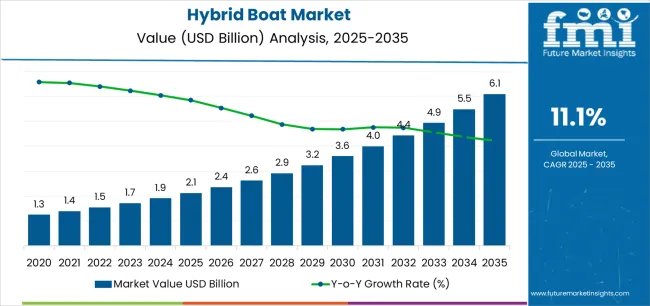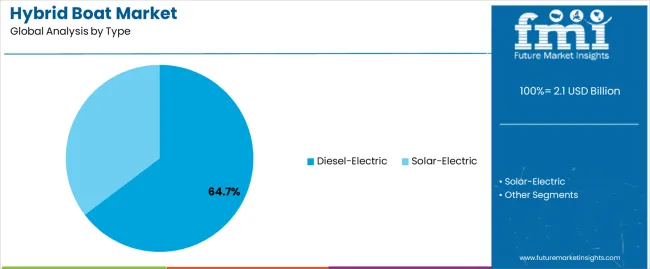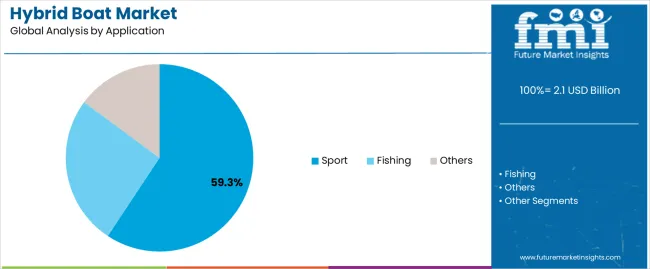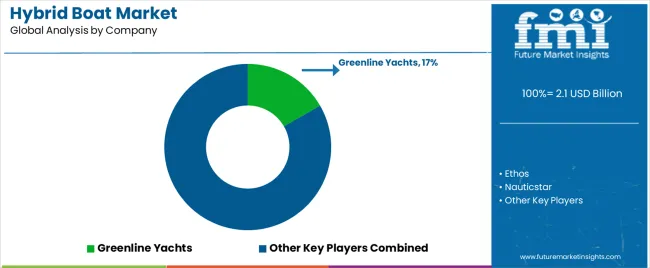The Hybrid Boat Market is estimated to be valued at USD 2.1 billion in 2025 and is projected to reach USD 6.1 billion by 2035, registering a compound annual growth rate (CAGR) of 11.1% over the forecast period.
The hybrid boat market is gaining traction, driven by increasing environmental regulations, rising fuel costs, and growing interest in sustainable marine transportation. The integration of hybrid propulsion systems has enabled vessel operators to achieve enhanced fuel efficiency and reduced emissions while maintaining operational performance.
The market benefits from advancements in energy storage systems, power management technologies, and lightweight materials that optimize hybrid designs. Growing consumer awareness of eco-friendly recreation and the expansion of hybrid solutions across commercial, leisure, and defense segments have further strengthened growth.
The transition toward electrification in marine mobility is being encouraged by government incentives and port authorities promoting green operations. As technological maturity improves and infrastructure for charging and maintenance expands, the hybrid boat market is expected to witness significant adoption across both private and commercial categories over the forecast period.

| Metric | Value |
|---|---|
| Hybrid Boat Market Estimated Value in (2025 E) | USD 2.1 billion |
| Hybrid Boat Market Forecast Value in (2035 F) | USD 6.1 billion |
| Forecast CAGR (2025 to 2035) | 11.1% |
The market is segmented by Type and Application and region. By Type, the market is divided into Diesel-Electric and Solar-Electric. In terms of Application, the market is classified into Sport, Fishing, and Others. Regionally, the market is classified into North America, Latin America, Western Europe, Eastern Europe, Balkan & Baltic Countries, Russia & Belarus, Central Asia, East Asia, South Asia & Pacific, and the Middle East & Africa.

The diesel-electric segment dominates the type category with approximately 64.7% share, supported by its proven reliability and efficiency in hybrid vessel operation. This configuration allows optimization of engine load, minimizing fuel consumption and extending engine life while maintaining sufficient power output for propulsion and onboard systems.
The segment benefits from its adaptability across a wide range of vessel sizes, from small yachts to passenger ferries, making it the most commercially viable hybrid solution. Cost-effectiveness, established maintenance infrastructure, and technological familiarity among operators have further reinforced adoption.
The combination of electric propulsion for low-speed operations and diesel power for endurance ensures flexibility in diverse marine conditions. With continued advancements in electric drivetrain integration and emission compliance technologies, the diesel-electric segment is expected to remain the market leader in hybrid propulsion systems.

The sport segment accounts for approximately 59.3% share of the application category, driven by rising demand for high-performance boats that combine sustainability with dynamic operation. Owners and manufacturers of recreational and leisure vessels have increasingly adopted hybrid configurations to achieve quiet cruising, rapid acceleration, and reduced operational costs.
Growing environmental consciousness among affluent consumers and marina operators has contributed to hybrid adoption in this segment. The sport category also benefits from technological spillover from automotive hybrid systems, improving performance optimization and energy recovery efficiency.
With the luxury and recreational boating industry shifting toward cleaner propulsion solutions, the sport segment is anticipated to maintain its leading share through enhanced design innovations and supportive environmental policies.
The scope for global hybrid boat market insights expanded at a 15.1% CAGR between 2020 and 2025. The market is anticipated to develop at a CAGR of 11.7% over the forecast period from 2025 to 2035.
| Historical CAGR from 2020 to 2025 | 15.1% |
|---|---|
| Forecast CAGR from 2025 to 2035 | 11.7% |
Between 2020 and 2025, the global market witnessed substantial growth, with a CAGR of 15.1%. This surge can be attributed to increasing consumer awareness of environmental sustainability, prompting a shift towards hybrid boats that combine traditional fuel and electric power sources.
The period saw robust market expansion as manufacturers focused on technological advancements and innovation, enhancing the appeal of hybrid boats to eco-conscious consumers.
The market is poised for continued development, albeit slightly moderated. Projections indicate a CAGR of 11.7% from 2025 to 2035. Despite a marginally lower growth rate, the forecast suggests sustained demand for hybrid boats.
This phase is characterized by a more mature market, where ongoing improvements in battery technology, regulatory support, and a solid foundation laid in the preceding years contribute to the continued success of hybrid boats in meeting the evolving preferences of consumers seeking both performance and environmental responsibility.
| Attributes | Details |
|---|---|
| Opportunities |
|
The table emphasizes the CAGRs in five pivotal countries, namely the United States, Japan, China, the United Kingdom, and South Korea.
South Korea emerges as a dynamic and rapidly advancing market, poised for significant growth with an impressive 14% CAGR expected by 2035. Recognized for its commitment to innovation, the country is pivotal across various industries, showcasing a thriving economic landscape marked by continuous progress.
The substantial CAGR highlights the proactive approach to embracing and propelling advancements in the market, solidifying its position as a key contributor to the global industry. This underscores the dedication to sustainable practices, positioning South Korea as a notable player driving positive global developments within the hybrid boat sector.
| Countries | CAGR from 2025 to 2035 |
|---|---|
| The United States | 11.9% |
| Japan | 13.2% |
| China | 12.3% |
| The United Kingdom | 13% |
| South Korea | 14% |
The United States exhibits a robust 11.9% CAGR, driven by a combination of factors. Environmental consciousness is rising, propelling the demand for sustainable recreational options.
The vast inland waterways and coastal regions create ample opportunities for hybrid boats, meeting the diverse needs of American boaters. Government initiatives and incentives encourage the adoption of eco-friendly technologies, contributing to the growth of the market in the United States
A strong commitment to technological innovation and environmental sustainability influences the 13.2% CAGR in the market. With a rich maritime culture, consumers are increasingly drawn to hybrid boats for their eco-friendly features.
Government support for clean energy initiatives and a penchant for cutting-edge technologies contribute to the rapid adoption of hybrid boats, making Japan a key market for sustainable marine transportation.
With a 12.3% CAGR, China reflects a growing demand for hybrid boats fueled by the expanding middle class and a burgeoning interest in water-based recreational activities.
As environmental concerns gain prominence, consumers seek greener alternatives, making hybrid boats an attractive choice. Government initiatives promoting green transportation align with the market trend, further boosting the adoption of hybrid boats across an extensive network of rivers, lakes, and coastal areas.
The United Kingdom 13% CAGR is driven by environmental awareness, stringent regulations, and a strong maritime heritage. British consumers, conscious of ecological impact, are increasingly turning to hybrid boats.
The United Kingdom commitment to reducing carbon emissions in the maritime sector aligns with the eco-friendly features of hybrid boats, making them a preferred choice. The diverse water bodies in the region create opportunities for hybrid boat enthusiasts, contributing to market growth.
The impressive growth rate at 14% CAGR is attributed to a culture of technological excellence and a keen interest in sustainable practices. The thriving shipbuilding industry leverages expertise to produce advanced hybrid boats.
With a picturesque coastline and an emphasis on eco-friendly solutions, South Korean consumers embrace hybrid boats for leisure and practical transportation. Government support and a tech-savvy population further propel the market growth in South Korea.
The table below provides an overview of the hybrid boat landscape on the basis of type and application. Diesel-Electric is projected to lead the type of market at an 11.5% CAGR by 2035, while sport in the application category is likely to expand at a CAGR of 11.3% by 2035.
The prominence of diesel-electric hybrid boats is driven by their superior fuel efficiency and extended range. The dominance of the sport application category is propelled by the versatility and high-performance hybrid boats offer in sporting activities.
| Category | CAGR from 2025 to 2035 |
|---|---|
| Diesel-Electric | 11.5% |
| Sport | 11.3% |
The data indicates that diesel-electric hybrid boats are anticipated to dominate the market, with a projected CAGR of 11.5% by 2035. This underscores a sustained preference for hybrid boats integrating diesel and electric propulsion systems, combining efficiency and environmental considerations.
The sports segment is poised for substantial expansion in the application category, projecting a CAGR of 11.3% by 2035. This signals a growing demand for hybrid boats in recreational and sporting activities, emphasizing the appeal of eco-friendly and versatile watercraft for enthusiasts seeking both performance and sustainability.
The dual emphasis on diesel-electric technology and sporting applications reflects the evolving landscape of the market, catering to diverse consumer preferences and environmental concerns.

The competitive landscape of the hybrid boat market is characterized by active industry players vying for market share and innovation. Manufacturers are engaged in continuous research and development to enhance technological features, improve performance, and address environmental concerns.
Robust competition fosters a variety of offerings to cater to diverse consumer preferences.
Key market players are establishing strategic collaborations and partnerships to leverage combined expertise and accelerate advancements in propulsion technologies. This collaborative approach enhances market penetration and strengthens the industrial position in promoting sustainable boating practices.
Effective marketing strategies to differentiate products and capture consumer attention mark the competitive environment.
Companies are focusing on branding efforts that highlight the eco-friendly aspects of hybrid boats, aligning with the increasing global emphasis on environmentally responsible choices. As the market evolves, competitive dynamics drive innovation, fostering a dynamic landscape in the hybrid boat industry.
Key Market Developments
| Attributes | Details |
|---|---|
| Estimated Market Size in 2025 | USD 2.1 billion |
| Projected Market Valuation in 2035 | USD 6.1 billion |
| CAGR Share from 2025 to 2035 | 11.1% |
| Forecast Period | 2025 to 2035 |
| Historical Data Available for | 2020 to 2025 |
| Market Analysis | Value in USD billion |
| Key Regions Covered | North America; Latin America; Western Europe; Eastern Europe; South Asia and Pacific; East Asia; Middle East and Africa |
| Key Market Segments Covered | By Type, By Application, By Region |
| Key Countries Profiled | United States, Canada, Brazil, Mexico, Germany, United Kingdom, France, Spain, Italy, Poland, Russia, Czech Republic, Romania, India, Bangladesh, Australia, New Zealand, China, Japan, South Korea, GCC Countries, South Africa, Israel |
| Key Companies Profiled | Ethos; Nauticstar; Bavaria Motorboats; Greenline Yachts; Nautique Boats; Rand Boats; Domani Yachts; Duffy Electric Boats; Greenline Yachts; Silent Yachts |
The global hybrid boat market is estimated to be valued at USD 2.1 billion in 2025.
The market size for the hybrid boat market is projected to reach USD 6.1 billion by 2035.
The hybrid boat market is expected to grow at a 11.1% CAGR between 2025 and 2035.
The key product types in hybrid boat market are diesel-electric and solar-electric.
In terms of application, sport segment to command 59.3% share in the hybrid boat market in 2025.






Full Research Suite comprises of:
Market outlook & trends analysis
Interviews & case studies
Strategic recommendations
Vendor profiles & capabilities analysis
5-year forecasts
8 regions and 60+ country-level data splits
Market segment data splits
12 months of continuous data updates
DELIVERED AS:
PDF EXCEL ONLINE
Hybrid Printing Market Forecast Outlook 2025 to 2035
Hybrid Metal-Paper Seamers Market Size and Share Forecast Outlook 2025 to 2035
Hybrid Sealing-Cut Machines Market Analysis - Size and Share Forecast Outlook 2025 to 2035
Hybrid Powertrain Market Size and Share Forecast Outlook 2025 to 2035
Hybrid Additive Manufacturing Machines Market Size and Share Forecast Outlook 2025 to 2035
Hybrid Integration Platform Market Size and Share Forecast Outlook 2025 to 2035
Hybrid Marine Gensets Market Size and Share Forecast Outlook 2025 to 2035
Hybrid Meat Products Market Size and Share Forecast Outlook 2025 to 2035
Hybrid Generator Sets Market Size and Share Forecast Outlook 2025 to 2035
Hybrid Switchgear Market Size and Share Forecast Outlook 2025 to 2035
Hybrid Rice Seeds Market Size and Share Forecast Outlook 2025 to 2035
Hybrid Memory Cube Market Size and Share Forecast Outlook 2025 to 2035
Hybrid Aircraft Market Size and Share Forecast Outlook 2025 to 2035
Hybrid Solar Wind Market Size and Share Forecast Outlook 2025 to 2035
Hybrid Cutters Market Analysis Size and Share Forecast Outlook 2025 to 2035
Hybrid Fabrics Market Size and Share Forecast Outlook 2025 to 2035
Hybrid Train Market Analysis - Size, Share, and Forecast Outlook 2025 to 2035
Hybrid Solar Wind Energy Storage Market Size and Share Forecast Outlook 2025 to 2035
Hybrid Drivetrain Market Size and Share Forecast Outlook 2025 to 2035
Hybrid Emulsifier Market Size and Share Forecast Outlook 2025 to 2035

Thank you!
You will receive an email from our Business Development Manager. Please be sure to check your SPAM/JUNK folder too.
Chat With
MaRIA